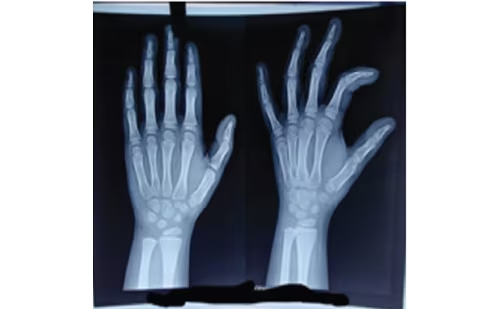Hormones affect specific behaviour, both temporarily, by changing peripheral and neural processes (‘activation process’), and permanently, by affecting early brain development (‘organisational process’).
Hormones affect specific behaviour, both temporarily, by changing peripheral and neural processes (‘activation process’), and permanently, by affecting early brain development (‘organisational process’). Activation and organisational processes may interact; thus, aggressive behaviour in boys may result from the temporal action of testosterone, which is superimposed on that hormone’s permanent effect on brain development in boys.1 Distinguishing between a hormone’s permanent and temporal effects on brain function is important when considering the reversibility of (neuro)psychological consequences of the actions of hormones.
For instance, if cognitive impairment in patients suffering from growth hormone deficiency (GHD) mainly results from impaired brain development, there would seem to be little point in administering GH to normalise brain function. In light of this, it is important to be aware that GHD patients can be diagnosed as belonging to one of a number of subgroups. A first distinction can be made between GH deficiency that is present from birth or commencing in early childhood (childhood-onset GHD (CO-GHD)) and pituitary function declining later in life (adult-onset GHD (AO-GHD)), frequently caused by a pituitary tumour. In these patients, the brain function may be impaired by either the tumour itself or the associated treatment (surgery and/or radiotherapy).
A second distinction is made regarding the extent of pituitary failure. One diagnosis is isolated GHD (IGHD), in which only GH secretion is insufficient. IGHD is usually present from childhood and may thus be characterised as a chronic disease. Another is multiple pituitary hormone deficiency (MPHD), which involves GHD in addition to the impaired secretion of other pituitary hormones (i.e. adrenocorticotropic hormone (ACTH), thyroidstimulating hormone (TSH) and gonadotropins).
Each of these subgroups of patients may exhibit a different psychological profile, as cognitive impairment can be related to a variety of factors. One such factor is subnormal brain development resulting from GHD in childhood. Other possibilities include a GH-specific disturbance in neural cell metabolism related to the low activity of the somatotropic axis or brain damage caused by either a tumour or the associated surgical treatment and/or radiotherapy. Finally, inadequate replacement with thyroxine, adrenal steroids or sex steroids may adversely affect psychological functions. All the above factors may have their own implications for the efficacy of treatment.
Effects of GHD and GH Replacement on Mental Status
Cognitive functioning appears subnormal in patients with GHD. Both AO and CO patients complain of lapses of attention, difficulty in concentrating and forgetfulness.2–4 Also, both patients with IGHD and those with MPHD show memory impairment and subnormal intelligence quotient (IQ) scores. Moreover, their IQ score and educational level appear to be positively related to the concentration of insulin-like growth factor I (IGF-I), a serum marker for GH status. This suggests that subnormal cognitive performance is specifically related to GHD.5 However, as IQ scores for patients with IGHD generally tend to be higher than those for patients with MPHD, a combined deficiency of pituitary hormones during a critical period of brain development seems more harmful than GHD alone.6,7
GH substitution in GHD patients appears to be beneficial for cognitive functioning, as assessed by tests measuring memory and attention. For instance, six months of GH treatment was found to enhance patients’ scores on the symbol–number association subtest of the Wechsler Adult Intelligence Scale (WAIS), indicating that intellectual functioning had improved.8 In a later study with quite a large sample size (48 CO-GHD men), patients were randomly assigned to placebo or GH treatment. Placebo treatment was given for six months, and all groups eventually received GH replacement for two years. GH treatment was considered to be supra-physiological if serum IGF-I rose to a value exceeding the normal upper limit for the patient’s age and gender. During the placebo-controlled phase of the study, changes in memory were positively correlated to the GH-induced changes in serum IGF-I concentration.
At six months, however, only patients receiving supra-physiological GH treatment – and not those whose serum IGF-I had been normalised – showed memory improvements. After one year of treatment, memory functioning was found normalised in both groups of patients. This was maintained throughout the second year of treatment.9 These results demonstrate that GH replacement improves memory in adults with CO-GHD, while supra-physiological treatment accelerates the recovery of memory performance.
A more recent study evaluated the effects on memory of one year of GH treatment after a one-year period of GH discontinuation in CO-GHD patients who had previously received treatment. No improvements in memory were found during the one year of treatment. Nevertheless, positive correlations were found between IGF-I concentration and memory performance. On the basis of these findings, it was concluded that patients with a normal serum IGF-I concentration require at least one year of treatment before their memory improves.10
Also, studies in AO-GHD and mixed AO/CO-GHD groups indicate that GH treatment during six to nine months has positive effects on concentration, attention and comprehension.11,12 In contrast, no significant changes in IQ, memory and attention were observed after 18 months of GH therapy in a randomised double-blind placebo-controlled trial in 40 AO-GHD men.13 However, in another long-term treatment study in men with CO-GHD, memory improvement was seen after one year and maintained during 10 years of GH substitution.14 In the light of these contradictory findings, the effects of GH therapy on cognitive functioning in GH-deficient patients must still be considered rather equivocal.
Effects of GHD and GH Replacement on Wellbeing
According to several studies, GHD patients show emotional instability, a lack of energy and difficulties in social and sexual functioning and suffer from sleeping problems. In addition, compared with their siblings, GHD patients exhibit higher unemployment rates, lower marriage frequencies and more frequently lack a driving licence and live with their parents.5,15–17 Studies on the effects of GH replacement on wellbeing show conflicting results. For instance, GH therapy has frequently been found to increase self-perceived wellbeing and energy and to decrease pain, anxiety and depression.8,10–12,18–21 Long-term GH administration preserves these mood improvements (see Figure 1).14 In contrast, other investigators found no changes in psychological wellbeing or quality of life after GH treatment.9,13 In the context of these conflicting results, the authors performed a meta-analysis regarding the influence of GH replacement on patient-reported outcomes (i.e. quality of life, health status and wellbeing). Fifteen studies with a total of 830 patients were included. When compared with pre-treatment values, a large improvement in patient-reported outcomes was seen at three months of GH replacement, and a progressively decreasing improvement after six and 12 months of treatment (see Figure 2). However, when the authors compared the total effect of GH, implicating a median treatment duration of six months, with placebo, GH substitution appeared only as effective as placebo. Thus, the meta-analysis provides no convincing evidence that GH improves wellbeing in GH-deficient patients.22
Biochemical Explanations
The relationship of GH and IGF-I with cognitive functioning may be explained by numerous mechanisms. First, as GH treatment changes the concentration of homovanillic acid (HVA) in the cerebrospinal fluid (CSF), cognitive impairments in GHD patients may be caused by a reversible disruption of neural cell metabolism.23–25 Memory functions may be enhanced when the availability of GH alters the dopamine turnover, particularly in the dopamine-rich hippocampus.5 Second, it is known that GH can cross the blood–brain barrier and that binding sites for GH and IGF-I exist in the choroid plexus, hypothalamus, putamen, thalamus and hippocampus.24,26,27 The number of GH receptors in these brain areas, which are involved in memory processes, declines with age.28
Serum IGF-I levels in healthy elderly subjects correlate with cognitive functioning.29 Furthermore, IGF stimulates DNA and RNA synthesis, neurite formation, rates of protein synthesis, synaptogenesis and neuronal repair. In addition, IGF potentiates acetylcholine release from the hippocampus, which also experiences a dramatic decline in IGF-I protein levels and receptor density as a result of ageing.30 Finally, GH substitution in GH-deficient patients has been found to increase CSF levels of aspartate, an excitatory amino acid that is a ligand for the N-methyl-D-aspartate (NMDA) receptor.24 Activation of the NMDA receptor contributes to long-term potentiation of synaptic efficacy in the hippocampus, which is considered to be an inherent mechanism of memory consolidation in the mammalian brain.31 Moreover, it has been shown that activation of NMDA receptors in the basal forebrain modifies attentional functions.32 Attentional improvements post-GH treatment may therefore be mediated by GH-induced activation of NMDA receptors in the basal forebrain.
Similarly to cognitive functions, a number of mechanisms may be responsible for GH-induced improvement of wellbeing. First, mood changes may be associated with physical or cognitive improvements, a better mood being the consequence of an improved physical or cognitive status. Second, a decrease in the dopamine metabolite HVA in the CSF, as is observed after GH treatment, also occurs in depressed patients after treatment with antidepressants; GH-induced mood improvement may thus be associated with an altered turnover of dopamine.
The above observations provide a biological context that may explain how the GH/IGF-I axis is involved in mental status and wellbeing, and how GH replacement may normalise these functions in GHD patients. Regarding GH administration in adults, the optimal dose is still debated. The question is what dose provides positive effects on mental functions and/or wellbeing with minimum side effects.
Conclusions
The general picture that emerges regarding cognitive functioning in adult GHD patients is that mental status (including IQ) is subnormal in these patients. The impairment seems more pronounced in MPHD than in IGHD. Although conflicting results have been reported in connection with GH treatment and cognitive functions, there is evidence that GH treatment improves cognitive functioning in GHD patients. In the case of normal physiological GH replacement, it appears that a minimum treatment period of one year is required to achieve a normalisation of cognitive status.
While GH substitution may improve brain function, it may well be that IGF-I, rather than GH, is the main factor that directly influences cognitive functions. As increases in IGF-I concentrations have been found to be associated with memory improvement, IGF-I levels appear to be specifically related to cognitive status. Further studies are required to distinguish between the effects of GH and IGF-I on brain function. Although recombinant IGF-I is available, no data are available on the effect of IGF-I administration in GHD patients. Thus, in spite of conflicting research findings regarding the cognitive effects of GH treatment, the relationship between the GH/IGF-I axis and brain function is based on firm biological foundations.
As described above, GH treatment changes the concentration of HVA in CSF. Also, the presence of binding sites for GH and IGF-I in the brain may be important for cognitive processes. Finally, GH substitution may activate the NMDA receptor by increasing aspartate levels in the CSF. This may contribute to memory consolidation in the brain. The existence of these biological mechanisms makes it likely that GH treatment can indeed improve cognitive functions in GHD patients. GH replacement, however, has no proven beneficial effects in healthy elderly subjects or in patients who are not suffering from GHD.
Reduced wellbeing is also one of the symptoms of adults with GHD. The meta-analysis from Arwert et al.22 suggests that wellbeing significantly improves after three, six and 12 months of GH therapy, with the improvement being largest after three months and becoming progressively smaller with longer treatment duration. However, these results are restricted to comparisons with baseline. As reported above, the authors found no indication of a superior effect of GH replacement relative to placebo. The observed improvement in wellbeing may therefore be attributed to other factors than GH, such as the attention and care accompanying GH treatment, which may improve wellbeing more substantially than the contribution of GH itself. However, although it is not possible to definitely state that GH treatment is more efficacious than placebo in terms of improving mood states, there is still a lot of evidence favouring the beneficial role of GH treatment in wellbeing. ■







